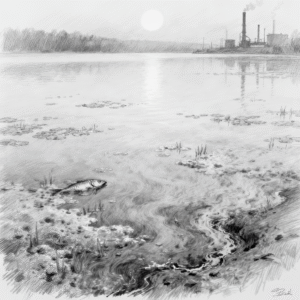
Environmental problems and sources of contamination due to phosphorus discharge into surface and groundwater
Environmental problems and sources of contamination due to phosphorus discharge into surface and groundwater
Introduction
Phosphorus (P) is a crucial nutrient for life, but its release in excessive quantities into aquatic ecosystems, often through inadequately treated wastewater discharges or unregulated activities, represents one of the main causes of environmental degradation. sources clearly indicate that the release of pollutants from human activities, including domestic and industrial sewage discharges, contributes to a significant deterioration of the ecological status of water resources.
- problems arising from phosphorus discharge into surface watersthe uncontrolled discharge of phosphorus into surface waters (rivers, lakes, coastal seas) triggers water quality deterioration processes that have both ecological and socio-economic consequences.
1.1 eutrophication and ecological degradation
the excess of phosphorus, along with other nutrients, fuels the massive and uncontrolled growth of algae and aquatic vegetation, a phenomenon known as eutrophication (as discussed in our previous conversation). to monitor this impact, the eutrophication/pollution diatom index (EPI-D) is used in running waters. the rapid deterioration of surface water quality is found in places classified as “poor” or “very poor” and, ultimately, “unsuitable” for drinking consumption due to anthropogenic contamination.
1.2 hypoxia and environmental consequences
one of the most serious consequences of excessive nutrient loading in the aquatic environment is hypoxia, which is the drastic reduction of dissolved oxygen levels. hypoxia (or oxygen deficiency) occurs when the excess algal biomass dies and decomposes on the bottom of the water body, consuming oxygen. sources highlight that hypoxia has ecological and economic consequences.
1.3 contribution of anthropogenic discharges
in general, surface water areas with poor quality (poor/extremely poor zone) are contaminated by a combination of human activities, including domestic sewage discharge, intensive industrial activities, and large-scale farming.
- problems related to phosphorus discharge into the subsoilthe study of phosphorus contamination in groundwater is complex, as phosphorus tends to adsorb strongly to soil particles. however, the presence of contaminants, including nutrients, can have direct and indirect effects on groundwater quality.
2.1 alteration of chemical composition
the discharge of pollutants has geochemical and ecological consequences due to the alteration of the chemical composition of groundwater. although sources do not specify the exclusive role of phosphorus in these phenomena, it falls into the category of pollutants that can modify the chemical environment of the subsoil.
2.2 mobility and infiltration in the filtering medium
some treatment practices (not necessarily related to phosphorus as a contaminant, but as an additive) suggest that phosphorus-containing compounds can affect penetration into the subsoil. for example, the addition of polyphosphates can promote deeper penetration of coagulated matter into the filter mass. this implies that phosphorus-based compounds can potentially increase the mobility of other substances or of phosphorus itself in filter systems or in the subsoil.
2.3 removal and adsorption
in treatment technologies that use the subsoil, such as subsurface flow (SSF) constructed wetlands (CW), a key mechanism for phosphorus removal is the adsorption of phosphorus to the substrate. if the phosphorus load exceeds the adsorption capacity of the medium, contamination of the subsoil or effluent waters may increase.
- main sources of wastewater discharge with phosphorus presencephosphorus is present in various types of discharges, particularly those related to human activity and agriculture. sources highlight that the impairment of surface water quality is caused by several types of discharges and activities, including:
3.1 domestic and civil discharges
domestic sewage discharge is a direct and significant cause of the worsening of surface water quality. phosphorus is abundant in municipal wastewater due to organic waste and the use of detergents.
3.2 agricultural activities and land use
large-scale farming and the irrational use of pesticides are cited as factors that negatively impact surface water quality, where phosphorus is a key component of fertilizers that can run off into water bodies.
3.3 industrial and related discharges
intensive industrial activities contribute to the contamination of surface waters. furthermore, ecological treatment technologies (such as CWs) are specifically studied to address complex industrial effluents, indicating that phosphorus is present in significant concentrations in various sectors, including:
tannery wastewater.
olive mill wastewater.
3.4 landfill activities
landfill activities are listed among the causes that negatively affect surface water quality, contributing to general contamination. landfill leachate can contain high concentrations of contaminants, including nutrients.
in summary, the presence of phosphorus in discharges, especially those from urban centers, agricultural activities, and industrial complexes, is a determining factor in classifying the ecological status of water bodies as unsuitable.


